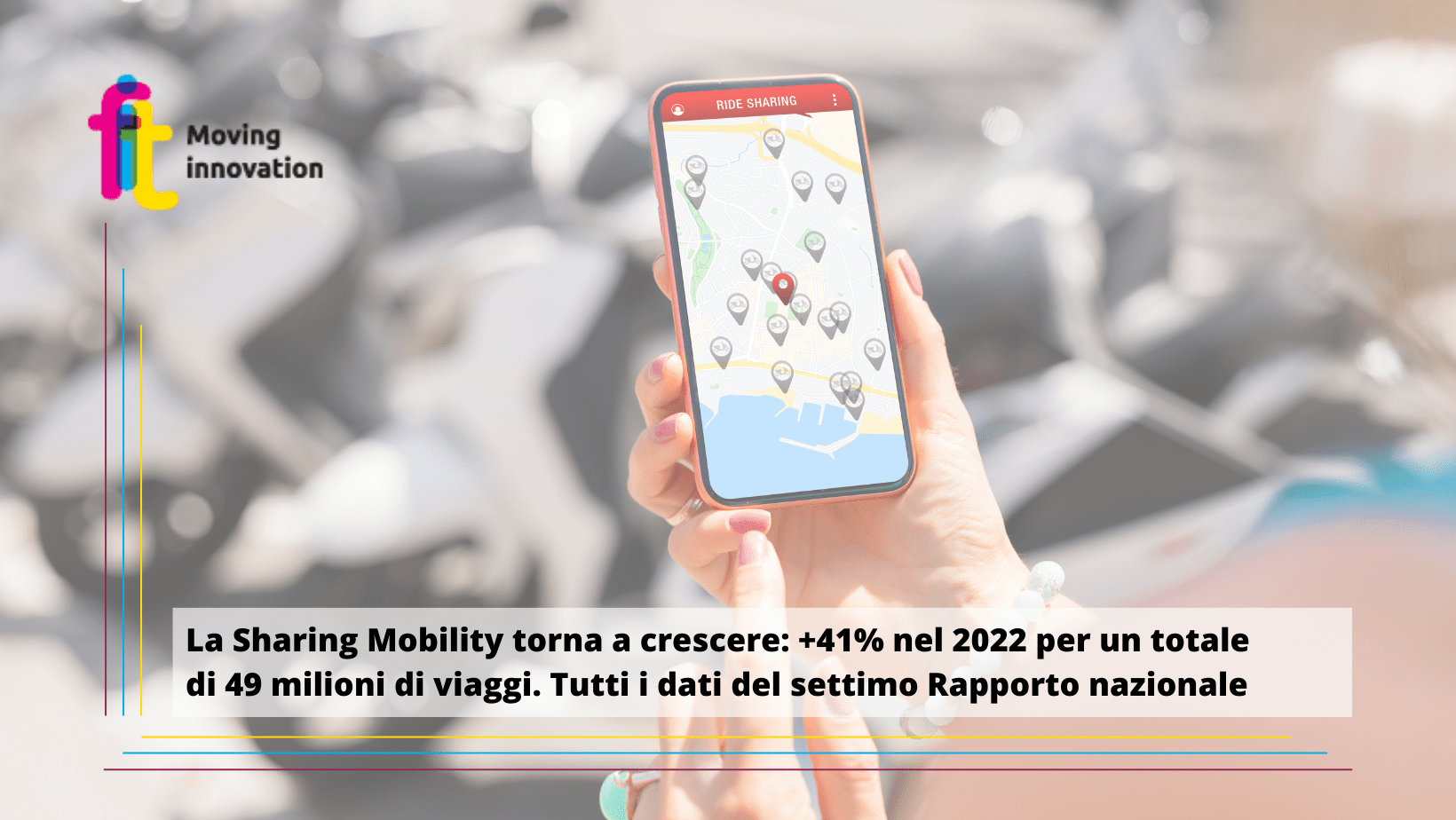Sharing Mobility is growing again: +41% in 2022 for a total of 49 million trips. All data from the 7th National Report
In 2022, sharing mobility returns to growth after the stop in previous years caused by the Pandemic. This is revealed by the Seventh national report on sharing mobility presented in early October at the conference ‘LESSCARS: decarbonisation of urban mobility’ organised by theNational Sharing Mobility Observatorypromoted by the Ministry of Infrastructure and Transport, the Ministry of the Environment and Energy Security and the Foundation for Sustainable Development at the Cassa Depositi e Prestiti headquarters.
According to the data presented, last year the number of total rentals in vehiclesharing grew by 41 per cent compared to 2021 for a total of around 49 million trips. The number of active services in Italian cities also increased, from 190 in 2021 to 211 in 2022, while the number of vehicles available to sharing mobility users rose from 89 thousand to 113 thousand.
On the other hand, the total turnover generated by the vehicle sharing sector in Italy exceeded 178 million euro in 2022, an increase of 38% compared to 2021. For the single-copter-sharing, station-based carsharing and free-floating bikesharing sectors, an increase in turnover between 2021 and 2022 is even estimated at +48%, +72% and +95% respectively.
THE STATE OF THE ART OF ITALIAN CITIES
As far as the state of the art in Italian cities is concerned, the signs are therefore encouraging: in 2022 there will be 67 provincial capitals in which a vehiclesharing service is active. However, the distance between northern cities and the rest of Italy still remains marked. Analysing the level of coverage of capital cities with sharing services, 77% are municipalities in the north, 50% in the centre of Italy and 48% in the south of Italy and the islands, which have, however, recovered 15 percentage points in just three years.
As anticipated, Milan is confirmed as the capital of Italian sharing mobility, both in terms of demand and supply of services, with 14.8 million total rentals and 30,700 vehicles available to users. It also ranks third in Europe for growth in micro-mobility sharing in 2023 (+21%), preceded by Berlin (1.7 million rentals – +306%) and Barcelona (+44%).
In Italy, the second largest city is Rome, with 12 million rentals and 29,300 vehicles in the sharing fleet.
GROWING NUMBER OF GREEN MEANS AVAILABLE TO USERS
More than 43 million (out of a total, let us remember, of about 49 million trips) are made using green means, such as bicycles, scooters and electric scooters. In particular, free-floating bikesharing grew by 108 per cent in 2022 compared to 2021; electric scootersharing by 42 per cent; electric scooter rentals (for which there is also a decrease in accidents) by 39 per cent and, finally, station-based bikesharing by 24 per cent.
Not to be outdone is the fleet figure: 95 per cent of the sharing fleet is zero-emission with a total of 107,000 light, space-saving and green vehicles, enabling citizens to get around faster and contributing to greater sustainability.
“A negative fact, however,” the Observatory’s report states, “is the reduction in the offer of scootersharing services that occurred at the turn of 2023, which in Italy led to the abandonment of the market by some major international players, the consequent 45% decrease in the number of vehicles and the closure of 12 out of 22 services”.
In general, the National Observatory of Sharing Mobility therefore notes a positive scenario as regards the decarbonisation of transport: in seven years’ time there should be a significant increase in the share of electric cars already envisaged in the National Energy and Climate Plan (6.6 million electric cars and plug-in hybrids by 2030) and a reduction in the private motorisation rate already envisaged in the Italian Long Term Strategy, i.e. 4.5 million fewer cars in 2030 than today (about 600 cars per 1,000 inhabitants, the same fleet as in 2007, against 683 today). This scenario, with a 30 per cent increase in public transport and sharing mobility, would lead to a reduction of 18 million tonnes of greenhouse gases (more than half of what the entire transport sector has to do).
HOW CARSHARING IS CHANGING
The 2022 statistics on the demand for free-floating carsharing confirm an ongoing structural change in the sector: the average rental distance has risen from 7.4 km/rental in 2019 to 12.2 in 2022, while the average rental duration has even tripled from 32 minutes/rental to 109 minutes/rental. This compares with the number of trips in 2022 at around 6.1 million, slightly up on 2021 (+7%), but still far below 2019 levels (-50%).
A trend that confirms a transformation in the business model of the service, which now addresses different user segments of sharing mobility than in the past, more oriented towards medium-long journeys. It should be noted, however, that one of the most critical aspects in 2022 was the reduction in the number of vehicles from 5,400 cars in 2021 to 4,600 cars in 2022.
A NEW FORM OF SHARING ADVANCES: THE DIGITAL DIAL-A-BUS
Finally, the National Observatory Report includes an in-depth look at DRT – Demand Responsive Transit services, i.e. on-demand bus and minibus services operating via digital platforms and online applications. These services have the potential to optimise the matching of supply and demand, offering more dynamic and flexible solutions in terms of routes and timetables for users.
In fact, the study shows that all the major digital platforms operating in the sector at international level are now also present in Italy, and among the transport operators that have launched DRT services and experiments are large companies and top-level players in Italian public transport. From an operational point of view, it is interesting to note that 65% of the services are intended to serve areas of weak demand, complementing traditional scheduled services.
The full report is available online on the website of the National Sharing Mobility Observatory. Click here.








